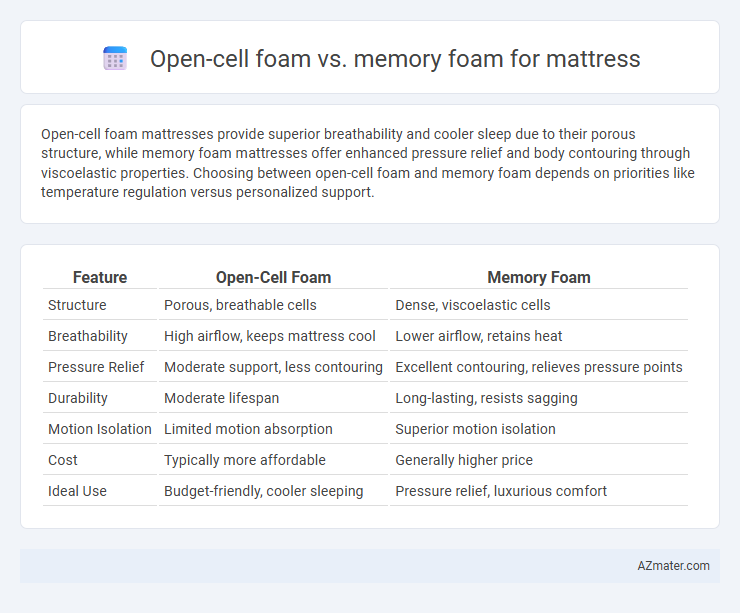Open-cell foam mattresses provide superior breathability and cooler sleep due to their porous structure, while memory foam mattresses offer enhanced pressure relief and body contouring through viscoelastic properties. Choosing between open-cell foam and memory foam depends on priorities like temperature regulation versus personalized support.
Table of Comparison
| Feature | Open-Cell Foam | Memory Foam |
|---|---|---|
| Structure | Porous, breathable cells | Dense, viscoelastic cells |
| Breathability | High airflow, keeps mattress cool | Lower airflow, retains heat |
| Pressure Relief | Moderate support, less contouring | Excellent contouring, relieves pressure points |
| Durability | Moderate lifespan | Long-lasting, resists sagging |
| Motion Isolation | Limited motion absorption | Superior motion isolation |
| Cost | Typically more affordable | Generally higher price |
| Ideal Use | Budget-friendly, cooler sleeping | Pressure relief, luxurious comfort |
Introduction to Mattress Foams
Open-cell foam features a porous structure that allows air to circulate, enhancing breathability and maintaining a cooler sleeping surface, making it ideal for hot sleepers. Memory foam, known for its viscoelastic properties, conforms closely to the body, providing pressure relief and support by evenly distributing weight. Both foams serve distinct purposes in mattresses, with open-cell foam prioritizing airflow and memory foam focusing on contouring comfort.
What is Open-Cell Foam?
Open-cell foam is a type of polyurethane foam characterized by an interconnected cellular structure that allows air to flow freely, making it breathable and cooling. It typically offers a softer, more responsive feel compared to memory foam, which contours closely to the body and retains heat due to its denser, closed-cell construction. Open-cell foam mattresses are ideal for sleepers seeking enhanced airflow and temperature regulation while maintaining comfort and support.
What is Memory Foam?
Memory foam is a viscoelastic polyurethane material known for its ability to conform to the body's shape and provide pressure relief by evenly distributing weight. Unlike open-cell foam, which features a porous structure for enhanced airflow and breathability, memory foam has a denser composition that traps heat but offers superior contouring support and motion isolation. This makes memory foam mattresses ideal for individuals seeking targeted comfort and reduced partner disturbance during sleep.
Breathability and Airflow Comparison
Open-cell foam offers superior breathability and airflow due to its porous structure, allowing heat and moisture to escape easily, which helps regulate body temperature throughout the night. Memory foam, characterized by its denser composition, tends to retain heat and restrict airflow, often leading to a warmer sleep environment. Choosing open-cell foam mattresses enhances ventilation and cooling, making them ideal for hot sleepers or those prone to night sweats.
Temperature Regulation: Which Foam Sleeps Cooler?
Open-cell foam excels in temperature regulation due to its open, porous structure that allows for superior airflow and heat dissipation, making it ideal for sleepers who tend to overheat. Memory foam, by contrast, is denser and retains body heat, often causing a warmer sleep experience unless infused with cooling gel or other temperature-mitigating technologies. For those prioritizing cooler sleep, open-cell foam mattresses generally provide better breathability and a more comfortable sleeping temperature.
Pressure Relief and Support Differences
Open-cell foam mattresses provide enhanced airflow and adaptive pressure relief by compressing and contouring quickly to body shape, promoting cooler sleep and reducing pressure points. Memory foam offers superior support through its viscoelastic properties, conforming slowly to the body to evenly distribute weight and alleviate stress on joints. The primary difference lies in open-cell foam's breathable structure versus memory foam's dense, heat-retentive composition, impacting both pressure relief responsiveness and support firmness.
Durability and Longevity
Open-cell foam mattresses offer enhanced breathability and faster response to pressure but typically have lower durability and a shorter lifespan compared to memory foam. Memory foam mattresses provide superior resilience and maintain shape over extended periods, often lasting 8 to 10 years with proper care, making them a more durable choice for long-term use. Choosing between the two depends on balancing breathability with the desire for prolonged mattress longevity.
Motion Isolation: Open-Cell vs Memory Foam
Memory foam excels in motion isolation due to its dense and contouring structure that absorbs and minimizes movement transfer across the mattress surface. Open-cell foam, while breathable and responsive, generally offers less effective motion isolation because of its more porous and less dense composition. For individuals sensitive to partner movements during sleep, memory foam mattresses deliver superior motion dampening compared to open-cell foam variants.
Allergen Resistance and Health Considerations
Open-cell foam offers superior breathability and naturally resists dust mites and mold, making it a healthier choice for allergy sufferers. Memory foam, while providing excellent support and pressure relief, can retain heat and trap allergens if not treated with antimicrobial agents. Selecting a mattress with CertiPUR-US-certified open-cell or memory foam ensures low VOC emissions and hypoallergenic properties for improved indoor air quality.
Choosing the Best Foam for Your Sleep Needs
Open-cell foam provides excellent breathability and pressure relief, making it ideal for hot sleepers or those needing enhanced airflow during rest. Memory foam contours closely to the body, offering superior support and motion isolation, which benefits individuals with joint pain or partners sharing a bed. Selecting the best foam requires considering temperature regulation preferences, body support requirements, and sleeping positions to ensure optimal comfort and restorative sleep.

Infographic: Open-cell foam vs Memory foam for Mattress
 azmater.com
azmater.com